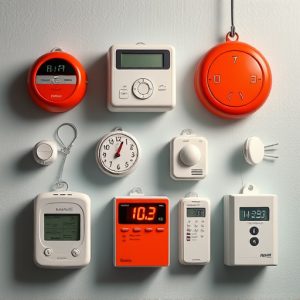Personal Protection Beacons: GPS Features & Best Distance Coverage Comparison
Personal protection beacons, compact gadgets with GPS and high-decibel alarms, enhance outdoor safet…….
Personal protection beacons, compact gadgets with GPS and high-decibel alarms, enhance outdoor safety (hiking, camping, urban exploration). Key consideration is understanding personal alarm distance ranges (0.5-10 km) for effective emergency communication. Compare features like automatic fall detection, water resistance, and battery life to ensure optimal device selection based on intended use cases and environmental conditions. "Personal Alarm Distance Range Comparison" is crucial for choosing a beacon that meets specific safety needs, balancing range, battery life, and advanced tracking capabilities.
Personal protection beacons with GPS are essential tools for safety in remote areas or emergencies. This comprehensive guide delves into understanding these devices, exploring their advanced GPS technology, and highlighting key features like alarm distance range. We break down factors influencing range comparison, providing insights to help you choose the best personal safety beacon tailored to your needs. Navigate through our detailed analysis for a clearer picture of these life-saving tools in an emergency scenario.
- Understanding Personal Protection Beacons: A Comprehensive Guide
- GPS Technology in Emergency Devices: Advantages and Features
- Evaluating Alarm Distance Range: Factors to Consider
- Comparitive Analysis: Unlocking the Best Personal Safety Beacon for Your Needs
Understanding Personal Protection Beacons: A Comprehensive Guide
Personal protection beacons, also known as personal alarm devices, are innovative tools designed to ensure your safety and provide a sense of security when you’re outdoors or in unfamiliar locations. These compact gadgets emit a high-decibel sound that can attract attention and deter potential threats, all while allowing you to send your location data to emergency services or trusted contacts via GPS.
When considering these devices, one of the most crucial factors is understanding their distance range. The personal alarm distance range varies among models, typically offering communication ranges between 0.5 and 10 kilometers (0.3 to 6.2 miles). It’s important to compare different brands and select one that suits your needs, whether it’s for hiking, camping, or everyday urban exploration. Some advanced models even feature features like automatic fall detection, water resistance, and long battery life, ensuring you’re prepared for any eventuality.
GPS Technology in Emergency Devices: Advantages and Features
GPS technology has revolutionized personal safety devices, especially in emergency situations. One notable example is the integration of GPS in personal protection beacons, which offers a range of advantages over traditional non-GPS models. These advanced devices can transmit an individual’s location data to emergency services with incredible accuracy, enabling swift response times. This feature is particularly useful in remote areas where traditional signaling methods may not be effective or when an individual finds themselves in a situation where they cannot easily communicate their location.
Furthermore, GPS enables a personal alarm device to provide a precise personal alarm distance range comparison. With real-time tracking capabilities, users can monitor and adjust the alert radius according to their needs, ensuring that help arrives promptly within the designated perimeter. This level of customization offers a sense of security, especially for individuals who frequently venture into unknown or potentially hazardous territories.
Evaluating Alarm Distance Range: Factors to Consider
When evaluating personal alarm distance ranges, several factors come into play. Firstly, consider the environment – urban areas with tall buildings may impede signal strength, whereas open countryside offers a clearer line of sight for GPS signals. The presence of water bodies or dense vegetation can also impact range. Secondly, different manufacturers design their beacons with varying specifications, so a direct personal alarm distance range comparison between models is essential. Some factors affecting this include the beacon’s power output, antenna type, and the quality of the receiver’s sensitivity.
Additionally, it’s crucial to consider intended use cases. If the beacon is designed for outdoor activities like hiking or camping, a longer range may be necessary to cover large areas. In contrast, personal protection in urban settings might require a shorter but more reliable range within crowded environments where signals can easily be obstructed.
Comparitive Analysis: Unlocking the Best Personal Safety Beacon for Your Needs
When choosing a personal protection beacon with GPS, understanding the varying distance ranges and features is paramount to ensuring your safety. Different models offer distinct alarm distances, typically ranging from 1-5 kilometers. This variation directly impacts how effectively the device can alert nearby individuals or emergency services in case of distress.
A comprehensive comparison of personal safety beacons should consider not only the maximum range but also factors like battery life, water resistance, and integration with mobile apps for real-time tracking. For instance, model A might boast a 5km range but offer poor battery longevity, while model B could have a slightly lower 3km range but provide advanced tracking features and longer-lasting power. Thus, aligning the beacon’s capabilities with your specific needs is crucial to unlocking the best solution for personal safety.
Personal protection beacons with GPS technology have evolved to become indispensable tools for safety and emergency situations. By understanding the various factors, including alarm distance range, one can make an informed decision while choosing the best beacon suited to their needs. This comprehensive guide highlights the advantages of GPS-enabled devices, offering a clearer view of the market and enabling users to navigate the landscape of personal safety beacons with confidence. With a strategic choice based on specific requirements, individuals can ensure they are prepared for any eventuality, leveraging technology to enhance their safety and peace of mind.


